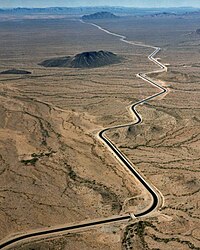
Photo from wikipedia
Horizontal wells are commonly used in bottom water reservoirs, which can increase contact area between wellbores and reservoirs. There are many completion methods used to control cresting, among which variable… Click to show full abstract
Horizontal wells are commonly used in bottom water reservoirs, which can increase contact area between wellbores and reservoirs. There are many completion methods used to control cresting, among which variable density perforation is an effective one. It is difficult to evaluate well productivity and to analyze inflow profiles of horizontal wells with quantities of unevenly distributed perforations, which are characterized by different parameters. In this paper, fluid flow in each wellbore perforation, as well as the reservoir, was analyzed. A comprehensive model, coupling the fluid flow in the reservoir and the wellbore pressure drawdown, was developed based on potential functions and solved using the numerical discrete method. Then, a bottom water cresting model was established on the basis of the piston-like displacement principle. Finally, bottom water cresting parameters and factors influencing inflow profile were analyzed. A more systematic optimization method was proposed by introducing the concept of cumulative free-water production, which could maintain a balance (or then a balance is achieved) between stabilizing oil production and controlling bottom water cresting. Results show that the inflow profile is affected by the perforation distribution. Wells with denser perforation density at the toe end and thinner density at the heel end may obtain low production, but the water breakthrough time is delayed. Taking cumulative free-water production as a parameter to evaluate perforation strategies is advisable in bottom water reservoirs.
Journal Title: Petroleum Science
Year Published: 2017
Link to full text (if available)
Share on Social Media: Sign Up to like & get
recommendations!